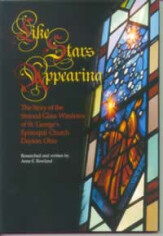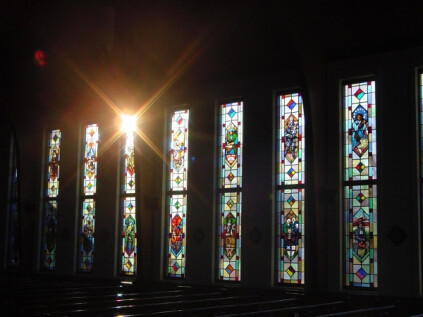Virtual Tour
The Episcopal Church
St. George's is a part of the Episcopal Church of the United States. "Episcopal" means having bishops who are the leaders of the church and spiritual descendants of the apostles of Jesus Christ. The Episcopal Church is part of the world-wide Anglican Communion which includes those churches derived from the Church of England. Its roots are in the Protestant Reformation of the 1500s, but what makes the Anglican (and Episcopal) Church unique is that it is both Catholic and Protestant. It is Protestant in content (its theology and doctrine) and yet Catholic in form (its liturgy, structure, etc.). Our faith is shaped by the ideas of justification by faith alone and the authority of Scripture, and yet we retain the historic offices of bishop, presbyters (priests), and deacons. We worship in a liturgical style drawn deeply from the ancient Western Christian tradition and celebrate Holy Communion every Sunday.
The Episcopal Church is divided into geographic regions, each region is called a diocese. Every diocese has a bishop who is the head of that diocese, and usually has a Cathedral where the bishop resides when not visiting parishes in their diocese. St. George's is part of the Diocese of Southern Ohio, which includes Cincinnati, Columbus, and Dayton, and extends east all the way to West Virginia. Our Bishop and Cathedral are located in Cincinnati.
The Church Year
The Episcopal Church observes the traditional Christian Calendar of the Western Church. The Church year begins with the season of Advent during which we prepare for Christmas. Advent begins on the Sunday closest to November 30. Christmas itself lasts twelve days, after which is the Feast of the Epiphany (January 6).
Lent is the forty days of preparation before Easter and begins on Ash Wednesday in February. Easter, the celebration of Jesus' resurrection from the dead, is followed by a season which lasts fifty days, concluding on Pentecost. The rest of the church year is considered the Season of Pentecost and goes until the start of the next Advent.
Vestments
To add to the beauty and festivity of the services, and to signify their special ministries, the clergy and other worship leaders wear vestments. Lay Readers and Choir vestments usually consist of an ankle-length, black robe called a cassock and a white over-gown called a cotta. Vergers, who are lay ministers who act as 'masters of ceremony' wear gray vestments, often trimmed with red, and carry a staff called a verge. The clergy also wear a black cassock with a longer white over-gown called a surplice. Over the surplice ordained ministers wear either a stole, a narrow band of colored fabric, or a tippet, which is a long, thick black band of fabric, also known as a preaching scarf. Clergy will also have two white "tabs" or bands which hang down from the front of their collar. These preaching bands represent the Old and New Testaments of the Bible, and that the preacher is charged with proclaiming the full Word of God. At a worship service the minister who is preaching that day will wear a tippet and may also be wearing an academic hood to signify their theological training to be a preacher. The minister who is leading the service, called the Celebrant, along with any other clergy assisting with Holy Communion, will wear a colored stole to match the church season color. Deacons wear the stole over one shoulder, priests and bishops over both shoulders.
Vestments and altar coverings are usually made of fabrics whose colors are changed with the seasons and holy days of the Church Year. The most frequently used colors are white, red, purple, green, and blue.
History
As growth in the Miami Valley in the 1950s began to expand south of Dayton, it was decided that starting a new Episcopal parish in the Kettering and Centerville area was needed. To this end, St. George's was founded in 1954 and first started meeting in the basement of a bank at Town & Country on Route 48. The nascent congregation moved to its current location in 1955 and began construction on a new church building, completed the following year. St. George's became a self-sufficient parish with a year, and to accommodate rapid growth, the church expanded and built a new worship space (the current one) in 1962. The original worship space was converted to a parish hall.
St. George's Milestones
|
March 1954 |
First service held in the basement of Merchant’s Bank in Kettering; 28 families comprise the entire congregation |
|
September 1954 |
Frederick A. Pope arrives from New Hampshire to serve as first vicar; St. George’s mission is officially established |
|
August 1955 |
Ground is broken for the present parish hall on land provided by the Diocese of Southern Ohio |
|
June 1956 |
Cornerstone is laid |
|
January 1957 |
St. George’s becomes a self-supporting parish |
|
March 1957 |
Church is incorporated under Ohio corporation law; St. George’s new parish home formally opens |
|
May 1957 |
St. George’s accepted as a full parish at Diocesan Convention; Vicar Frederick A. Pope becomes first Rector |
|
April 1961 |
Congregation outgrows original church and decides to build a new church and expand facilities |
|
June 1962 |
Ground broken for the new church |
|
September 1963 |
New church building is dedicated |
|
1966 |
The Reverend H.R. Wiechert succeeds Frederick A. Pope as the second Rector |
|
1977 |
The Reverend James S. Paget succeeds H.R. Wiechert as the third Rector |
|
September 1978 |
Mortgage for the new church paid in full; mortgage document is burned in celebration! |
|
1989 |
After ten years of saving and fundraising, a magnificent mechanical tracker organ is installed by C. B. Fisk, their Opus 94 |
| 1991 |
Reverend Carol W. Hull succeeds James S. Paget as the fourth Rector |
| 1994 |
St. George's completes its accessibility project, giving parishioners easier access to building facilities |
|
2000 |
The church installs beautiful new stained glass windows |
|
April 2001 |
A new custom cast bronze bell is hung in the church steeple |
|
2006 |
Additional property is purchased on Manor Lane to serve as the rectory (parsonage) |
|
August 2010 |
The Reverend Benjamin T. S. Phillips succeeds Carol W. Hull to be the Fifth Rector of St. George's |
|
November 2014 |
The Reverend Dr. Calvin Lane joins St. George's as Associate Rector |
|
August 2023 |
Recovering from the global pandemic, St. George's reaches pre-pandemic attendance |
Stained Glass Windows

St. George's has 48 stained glass windows in the chancel, narthex and nave of the church. There's even a book about them! If you'd like to purchase a copy of Anne Roweland's Like Stars Appearing for $10, please email to request a copy, or pick one up at our Welcome Center after a worship service. Make use of our Virtual Tour above to get a better look at these windows before you visit!

Completed in 2002, Saint George's stained glass windows are inspired by the hymn I Sing a Song of the Saints of God and reflect almost four years of planning, research and fabrication. They replace the crumbling and leaking original windows from 1962 which had more than lived out their expected 30-year life span. The window of Saint George himself in the narthex contains pieces of these original windows in the red cross of George's banner. Red is the most precious color of glass as its hue is achieved by the incorporation of gold dust within the melted glass.
St. George's windows are called "antique" glass (meaning new glass but hand blown by the traditional method) held in place by lead framing, protected by double panes of thermal glass on the exterior of the building. In years to come, the leading can be repaired and replaced making the life expectancy of these windows to be quite long.

The windows were designed by artist Joan Collins of Willet Studios of Philadelphia (now Willet Houser Architectural Glass, Inc.), one of the oldest glass studios in America. St. George's windows depict saints and historical figures which tell the story of God's call to people throughout history. Two points of interest are worth noting.
First, that the saints depicted cover a wide range of church history, with some being well known and often depicted (like Augustine, Francis, Margaret of Scotland, and Patrick), and others being either lesser know or not as frequently found in stained glass windows (like Hilda of Whitby, Joan of Arc, and Ignatius of Antioch). Numerous windows are figures unique to the Anglican Church and the Episcopal Church, such as Thomas Cranmer, Richard Hooker, Absolom Jones, and Florence Tim Oi Li. St. George's windows have been featured in publications around the world, including the Macau Times and a doctoral dissertation in Romania. There is even a window of beloved author and Christian apologist C.S. Lewis!
Second, as much as possible and within reason the figures are depicted as historically in context, rather than conformed to an idealistic standard. For example, Augustine, who is well known to history as being of North African Berber origins, is depicted as an African writing in the city of Hippo, quite different from the typical medieval versions of an European in cope and miter.
Continuing in the ancient tradition of communicating through glass work beauty, history, theology, and God's sovereign guidance over human lives, St. George's windows are not only objects of art but of inspiration—truly a gift of beauty and faith to the greater Dayton community.
